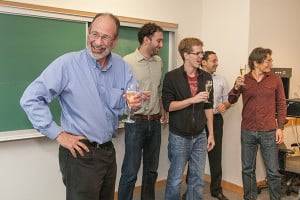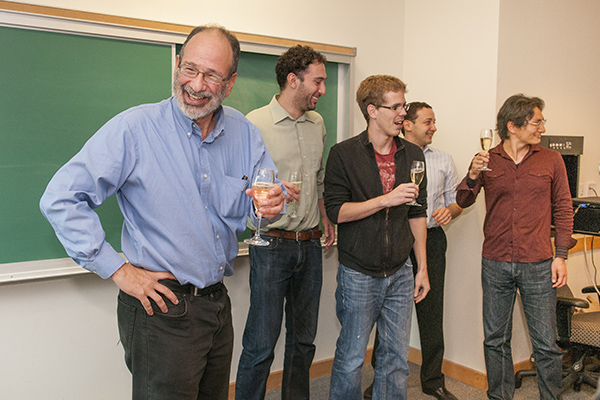
“I can’t talk to you about the world economy. I don’t know anything about the world economy!” Alvin Roth said to a journalist on the phone as he stepped off the treadmill in his office in the Landau Economics Building.
It might be surprising that Roth M.A. ’73 Ph.D. ’74, visiting professor of economics and this year’s winner of the Nobel Memorial Prize in Economic Science, claims not to know anything about economics. But Roth does not define himself as an economist.
“I went into operations research with the idea of fixing things up so they work better,” he said. “Operations research led me the game theory, which later on became economics. I just stayed where I was; the borders shifted.”
As the numerous congratulatory Elmo balloons floating around his office testify, Roth went on to become one of the most acclaimed economists in his field.
“He is there at the frontier of the fields of market design, game theory and experimental economists,” said Jonathan Levin ’94, chair of the economics department. “He is a real intellectual leader.”
As a teenager, Roth dropped out of high school in Queens, N.Y. because, according to a 2010 interview with Forbes, he felt “understimulated.” He went on to graduate from Columbia University in 1971 with a degree in Operations Research and received his masters and doctoral degrees in the same discipline from Stanford in 1973 and 1974. After a stint at the University of Illinois, he then moved on to the University of Pittsburgh. In 1998, he became the George Gund Professor of Economics and Business Administration at Harvard University and Harvard Business School, a position he will hold until January 2013.
Throughout his career, Roth brought to light the relatively new fields of game theory and market design, contributing to the very foundations of both disciplines. He is notably acclaimed for his work on the theory of matching markets.
Roth shared the Nobel prize with Lloyd Shapley, a professor emeritus at the University of California, Los Angeles, “for the theory of stable allocations and the practice of market design.”
When asked if he could explain what this description meant in layman’s terms, Roth answered jokingly, “Probably not, it usually takes me a quarter to explain what it means!”
“For a long time, economists studied markets the way botanists studied plants,” he said. “‘Look at that, what a remarkable plant, let us be good scientists and describe how it’s constructed and how it works,’ and of course botanists were not expected to make new plants.”
Roth explained that in the same way botanists have now started to engineer new plants, economists have realized that the markets they observe suffer certain kinds of failures. Market design is about making them work better.
So far, Roth has made kidney donor matching, the national medical residency program and New York and Boston public high school systems all work better.
“He is a really great representative of economics because he is working on problems that are applications of economics to make the world a better place,” Levin said. “He is trying to figure out how to let students pick schools to let as many of them get into the one they want or get as many people off the kidney transplant list as possible.”
Roth received the call from Sweden at 3:30 a.m. on Monday morning while, predictably, he was sound asleep. The Royal Swedish Academy of Sciences gave him 25 minutes to prepare a press conference.
“[The Nobel] wasn’t expected in the sense that I was sound asleep,” he said. “I did not think I was going to get this Nobel Prize, but it wasn’t a crazy thought.”
Indeed, Roth has been nominated for the prize for a long time now.
“They nominate you and you fill out a form but you never know if they are going to pick you,” he said. “They have their own process. It is a very Swedish process.”
Levin, however, predicted the win.
“He gave a fabulous talk in my class on Friday,” he said. “I had told my students to show up since the guest lecturer they were about to listen to might win the Nobel prize the following Monday, and he did!”
While Roth is at the forefront of market design research and theory, Levin explained that he always finds time for his students, for whom he has great affection. Four of his former doctoral advisees are now faculty members at Stanford, a record matched only by professor of economics Kenneth Arrow, who also received a Nobel prize in economics back in 1972.
“Al is one of the nicest people I know, ” said Muriel Niederle, professor of economics and a former doctoral advisee of Roth’s in an email to The Daily. “Al as an advisor is almost like Al as a parent: he is very invested in his students, very accessible, and he deeply cares…his door was always open, and usually you would find a student (or a former student visiting) inside.”
This close relationship with his students was one of the biggest factors that caused Roth to choose to move from Harvard to Stanford last year, after 14 years spent in Cambridge. He will become a full-time professor beginning January 2013.
“Harvard was great but one of the biggest attractions of Stanford was that many of my wonderful students are professors here, and I get to be their colleague now,” he said.
His former students see him as more than just a colleague. For example, Roth is almost always on the guest list of his former students’ weddings, and has even officiated one.
Roth’s schedule will remain busy over the next few weeks and months. He has scheduled interviews with journalists from The Economist, the Los Angeles Times and the New York Times and will attend both a White House reception, as well as his award ceremony in Stockholm.
“The ceremony is on Dec. 10, which is the anniversary of Alfred Nobel’s birth. Or death,” he said. “Maybe I should get that fact straight before the ceremony.”
